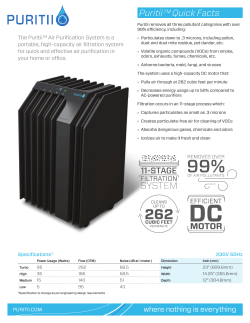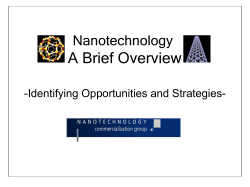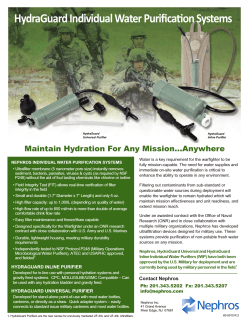
Dr. Shamsa Kanwal
Dr. Shamsa Kanwal The scarcity of clean water is expected to worsen in the future due to over usage, lack of conservation methods and dwindling natural supply of clean water, even in countries with significant water resources. Many hazardous pollutants enter the water supply through many channels, including waste disposal, industry effluent release or rain water drainage. Such pollutants need to be removed before the water can be consumed. However, most water purification technologies are not accessible to economically disadvantaged people around the world. The challenge for scientists is to develop robust water purification methods that could carry out water treatment at low cost, with minimal energy consumption and using less chemicals in the process so as to reduce negative impact on the environment. " exhibit key physicochemical properties that make them particularly attractive as high capacity and selective adsorbents for water treatment," "They can increase their affinity toward compounds including dissolved solutes such as toxic metal ions and organic pollutants. This is how nanostructuring allows you to achieve better performance.“ By knowing how the nanoscale works, we can make much more efficient absorbents that target certain types of pollutants that we couldn't do before, and it allows us to treat water better, treat water more cheaply and treat water faster than we have in the past, and those kinds of products are starting to show up out there." As a whole, the development of nanotechnology in membranes, adsorbents and other filtration techniques is starting to grow and be increasingly utilized across the water sector. Along with membranes and adsorbents, substances like nanocatalysts and nanoporous materials can also aid the water and wastewater treatment process. In all, researchers are finding that nanotechnology can be used in nearly any type of purification process and offers a number of advantages to water professionals and consumers alike looking to utilize its applications. There are several nanotechnology approaches to water purification currently being investigated and some already in use. "Water treatment devices that incorporate nanoscale materials are already available, and human development needs for clean water are pressing," Researchers at the D.J. Sanghvi College of Engineering, india Continued… The impurities that nanotechnology can tackle depend on the stage of purification of water to which the technique is applied. It can be used for removal of sediments, chemical effluents, charged particles, bacteria and other pathogens. Toxic trace elements such as arsenic, and viscous liquid impurities such as oil can also be removed using nanotechnology. "The main advantages of using nanofilters, as opposed to conventional systems, are that less pressure is required to pass water across the filter, they are more efficient, and they have incredibly large surface areas and can be more easily cleaned by back-flushing compared to conventional methods," Carbon nanotube membranes can remove almost all kinds of water contaminants including turbidity, oil, bacteria, viruses and organic contaminants. Although their pores are significantly smaller carbon nanotubes have shown to have an equal or a faster flow rate as compared to larger pores, possibly because of the smooth interior of the nanotubes. Nanofibrous alumina filters and other nanofiber materials also remove negatively charged contaminants such as viruses, bacteria, and organic and inorganic colloids at a faster rate than conventional filters. Water purification membranes enhanced by plasma-treated carbon nanotubes are ideal for removing contaminants and brine from water. The study paves the way for the next generation of portable water purification devices, which could provide relief to the 780 million people around the world who face every day without access to a clean water supply. * HuiYing Yang, Zhao Jun Han, Siu Fung Yu, Kin Leong Pey, Kostya Ostrikov, Rohit Karnik. Carbon nanotube membranes with ultrahigh specific adsorption capacity for water desalination and purification. Nature Communications, 2013; 4 Continued… These membranes could be integrated into portable water purification devices the size of a tea pot that would be rechargeable, inexpensive and more effective than many existing filtration methods. Contaminated water would go in one end, and clean drinkable water would come out the other. "Small portable purification devices are increasingly recognised as the best way to meet the needs of clean water and sanitation in developing countries and in remote locations, minimising the risk of many serious diseases," Continued… "The large industrialized purification plants we see in other parts of the world are just not practical -- they consume a large amount of energy and have high labor costs, making them very expensive to run." Most water purifiers work by trapping bacteria in tiny pores of filter material. Pushing water through those filters requires electric pumps and consumes a lot of energy. In addition, the filters can get clogged and must be changed periodically. The new material, in contrast, has relatively huge pores, which allow water to flow through easily. And it kills bacteria outright, rather than just trapping them. David T. Schoen, Alia P. Schoen, Liangbing Hu, Han Sun Kim, Sarah C. Heilshorn, Yi Cui. High Speed Water Sterilization Using One-Dimensional Nanostructures. Nano Letters, 2010; 10 (9): 3628 Continued… Contact with silver and electricity can destroy bacteria! Therefore spreading sub-microscopic silver nanowires onto cotton, and then by adding a coating of carbon nanotubes, which gives the filter extra electrical conductivity. Tests of the material on E. coli-tainted water showed that the silver/electrified cotton killed up to 98 percent of the bacteria. The filter material never clogged, and the water flowed through it very quickly without any need for a pump. Scientists have developed a way to transform ordinary sand -- a mainstay filter material used to purify drinking water throughout the world -into a "super sand" with five times the filtering capacity of regular sand. The new material could be a low-cost boon for developing countries, where more than a billion people lack clean drinking water, according to the report in the ACS journal Applied Materials & Interfaces. Wei Gao, Mainak Majumder, Lawrence B. Alemany, Tharangattu N. Narayanan, Miguel A. Ibarra, Bhabendra K. Pradhan, Pulickel M. Ajayan. Engineered Graphite Oxide Materials for Application in Water Purification. ACS Applied Materials & Interfaces, 2011, DOI: 10.1021/am200300u Sand has been used to purify water for more than 6,000 years, and sand or gravel water filtration is endorsed by the World Health Organization. Studies of a nanomaterial called graphite oxide (GO) suggest that it could be used to improve sand filtration in a cost-effective way. A simple method has been developed to coat sand grains with graphite oxide, creating a super sand that successfully removed mercury and a dye molecule from water. In the mercury test, ordinary sand was saturated within 10 minutes of filtration, while the super sand absorbed the heavy metal for more than 50 minutes. Its filtration "performance is comparable to some commercially available activated carbon," Tomato peels can effectively remove different contaminants in water, including dissolved organic and inorganic chemicals, dyes and pesticides, and they can also be used in large scale applications. Similar to tomato peels, apple peels can also remove a range of dissolved water pollutants through the adsorption process. In order to enhance the ability of apple peels towards extraction of negatively charged pollutants, researchers immobilised naturally occurring zirconium oxides onto the surface of apple peels. Zirconium loaded apple peels were found to be able to extract anions such as phosphate, arsenate, arsenite, and chromate ions from aqueous solutions. This method of water purification can also be used for large scale applications. Scientists are struggling that the findings on the use of apple and tomato peels for water purification can be applied to benefit economically and technologically disadvantaged farmers living in remote villages, who depend on contaminated ground water or local rivers for their daily water needs. They intend to work with nongovernmental organisations to transfer their research findings and knowledge to benefit the people. Have put the conservatism of the water industry aside, and are thinking smaller to make sure people don't go thirsty. In South Africa, the humble teabag has inspired a way to clean water 1-litre at a time. In the mouth of an ordinary drinking bottle sits a teabag-like net that is a nanotech marvel. Developed by Eugene Cloete at Stellenbosch University in South Africa, the inside of the biodegradable teabag is coated with thin water-soluble polymer nanofibres that have been impregnated with anti-microbial agents and spun into a fine mesh. The material filters out most contaminants – up to 99.99% of bacteria. The "tea leaves" inside the bag are activated carbon, which can suck out heavy metals and other contaminants. As yet the tea bag remains a prototype, the final version, intended for consumers, is still being developed by the company AquaQure. But there is already much hope that this filter could make a big difference to the lives of people who do not have easy access to clean water. ---------------------------------------
© Copyright 2025
















